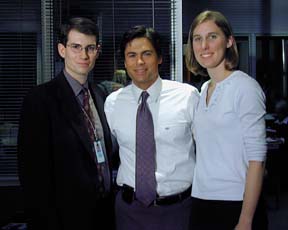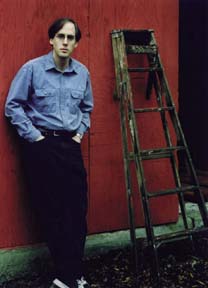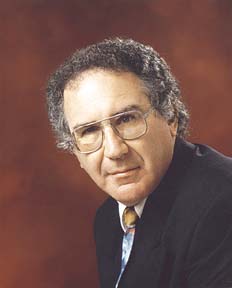'WORLD FLIGHT' DREAM STILL SOARS
When he finished his record-breaking flight around the world, Dan Dominguez
'00 felt as if he could accomplish anything. Now he's trying to share that idea
with people worldwide.
Dominguez and fellow pilot Chris Wall left September 13 and returned to Rochester
on December 15, making them the youngest team to fly around the world in an
airplane. Although the trip is over, the two are continuing to share their experiences
with others.
"From a pilot's perspective, it was different, it was daring," Dominguez
says. "But more important, I accomplished my dream. Now I feel like absolutely
anything is possible."
The two spent almost four years on the project, from finding and completely
refurbishing the plane-dubbed the Dreamcatcher-to raising money to support the
flight. Donations from singer Jimmy Buffet and AOL executive Bob Pittman, among
others, helped the dream become possible. The hard part over with, the trip
still had its share of thrills.
"We had a lot of adventures and excitement. Over Bahrain we lost the left
engine. We were engaged by a MIG [jet], we flew through a cyclone and just south
of a hurricane. It was quite an experience," Dominguez says. "Throughout
the process, we did everything from sleeping under our desk to hanging out with
movie stars."
During the trip, the two communicated with approximately 23 million students
worldwide through their Web site at www.worldflight2000.org.
They would meet with children when they landed in various countries and give
talks about their project and accomplishing dreams.
"That was the biggest reward-just seeing the spark in the kids' eyes,"
he says.
And even with the flight over, the work is far from complete. Through their
nonprofit organization, the Global Advancement Foundation, Dominguez and Wall
are trying to help other people achieve their dreams. Instead of raising money
for their own trip, they're now raising it to help others, such as one man who
plans to broadcast online during an extensive catamaran voyage.
While running the foundation and working as a pilot, Dominguez is keeping busy
writing two books about his experience. He still makes presentations at schools
throughout the country as well.
"The message from the whole thing is 'whatever your dream is, never give
it up'," he says. "You don't have to do exactly what we did, but if
I can tell people anything, it's to find your dream and make it happen."
WHITE HOUSE STAFFER FOR A DAY
 |
| Steve Mortimer (left) and wife Kathryn Jensen Mortimer with Rob Lowe. |
The way Steve Mortimer '94, '97S (MBA) sees it, he's got 14:57 of fame
still coming his way.
Mortimer successfully bid in the University's Sesquicentennial auction last
fall to appear in a Warner Brothers-produced show and found himself walking
on in an episode of NBC's White House drama The West Wing last March.
But don't be surprised if you missed him. His nonspeaking role consisted mostly
of sitting at a table, and his acting talents may be tough to gauge. The section
primarily showed the back of his head, but his face was visible as the scene
ended.
As easy as that sounds, Mortimer says his limited acting role was grueling
at times.
"It took about five hours to tape those 60 seconds," he says. "The
whole process was harder than you would have expected. I gained an appreciation
for how hard it is to remember lines and to get motivated, especially when you
have to do it over and over again."
Mortimer appeared on an episode titled "The Stackhouse Filibuster,"
in which a Senatorial grandfather stages a one-man filibuster a la Mr. Smith
Goes to Washington. In Mortimer's scene, Rob Lowe's character was poring over
government reports with various staffers, including Mortimer.
Although he is a West Wing fan, the fledgling actor was to be on an
episode of Friends, but his scene had to be cancelled.
Still, Mortimer was able to watch the Friends filming after his own
scene was done, and he and his wife, Kathryn Jensen Mortimer '97, have
pictures of themselves on several of the show's sets. They also got chummy with
Lowe.
"He was really friendly and acted very professional," Mortimer says.
"In fact, my wife says he did some really good Scooby Doo impressions."
Is there more acting in the future for this Boston-based assistant portfolio
manager? Not likely, he says. But the experience did give him a new take on
watching TV.
"When scenes are filmed many times from different angles like this was,
you get a lot of breaks in continuity," he says.
"I'm just a bit more of a critic now that I've seen what's behind the
magic."
ALUMNUS 'SCORES' WITH POLLOCK
 |
| Beal |
One of the most exciting moments of Jeff Beal's '85E career occurred
when someone else was being honored. When Marcia Gay Harden went to the stage
to receive the Oscar this year for best supporting actress for her role in the
film Pollock-a biography of abstract expressionist painter Jackson Pollock-the
orchestra briefly played music from the film, which was scored by Beal.
"A friend of mine who was a director called me later and said, 'Do you
realize your music was just heard by half a billion people?' I hadn't even thought
of that, but it's a pretty neat feeling," Beal says.
Beal, chosen by Pollock actor-director Ed Harris himself after two other composers
had been rejected, met Harris, discussed the film, and the two reached a similar
consensus on the mood of the music to accompany it. They have remained friends
since.
"He (Pollock) was the first American painter to define himself on the
level of the great Europeans, so we decided to take instruments associated with
Europe-like violin and a chamber group-and put them in a jazzier, more rhythmic
setting," Beal says.
"On an emotional level, this was a tough story. Pollock was really a tough
character. The music had to represent that, but it also had to be able to lift
people's spirits. It needed to end in the joy of his creation rather than wallowing
in his sadness."
Part of the challenge of this score, which consists of a more compositional
style of modern jazz, were entire scenes in which Harris, portraying the painter,
was creating his art.
"For several minutes, it's just him painting and the music. The music
takes on a role in the movie," Beal says. "For me, that's just wonderful,
thrilling. Movies like Pollock don't come around all the time."
Beal has scored other works as well, including Tom Hanks's miniseries From
the Earth to the Moon. He is working on two movies, including a TNT movie
with William H. Macey and Helen Mirren called Door to Door. He also just
released his latest album, Alternate Route (Unitone), which he describes
as primarily jazz trumpet and orchestra work.
"It's a mixture of jazz and classical influences, which is something I
love," Beal says. "I was exposed to classical music at Eastman and
have been around it since, so I still write a lot of classical music. It's always
part of who I am as an artist."
GRADUATES MAKE THE GRADE
Some of the top schools nationwide are turning to Rochester graduates to fill
vital roles.
Edwin Colodny '48, senior trustee of the University, was selected as
interim president of the University of Vermont. Colodny, who holds a law degree
from Harvard, is on the board of advisors for Vermont's business school and
was formerly chief executive officer of US Airways.
Phillip Pizzo '70M (MD) took over as dean of the Stanford University
School of Medicine in April. Formerly the chairman of Harvard Medical School's
pediatrics department as well as physician-in-chief at Boston Children's Hospital,
Pizzo is a specialist in the treatment of children with cancer and HIV.
Robert Dolan '77 (PhD) took over as dean of the University of Michigan
Business School in July. He formerly was senior associate dean and director
of the Harvard Business School's Division of Research.
Arthur Gaudio '64 was named dean of the School of Law at Western New
England College, beginning his tenure July 1.
SEX RESEARCHER MASTERS '43M (MD) DIES
William Masters, the man who may have been most instrumental in bringing
the discussion of sex and sexual dysfunction into mainstream America, died last
February from complications of Parkinson's disease. He was 85.
Masters, who received an honorary degree from the University in 1987, had planned
to specialize in sexual response and physiology in medical school, but while
attending Rochester he was urged by Professor George Washington Corner to first
establish a more respected practice instead of jumping into a controversial
field of study. He moved to St. Louis and set up an obstetrics and gynecology
practice before returning to the study of sex with partner, and later wife,
Virginia Johnson.
The two founded the Johnson and Masters Institution and published several books,
including Human Sexual Response in 1966 and Human Sexual Inadequacy
in 1970. Both were written for the scientific community but became best sellers
among the general public.
Masters' approach to his study was different from his predecessors. While others
focused on the psychological aspects of sex and depended on subjects' memories,
Masters and Johnson studied paid volunteers in the lab.
ALUMNI HONORS
Several University alumni have received national recognition for achievement
in their fields.
Hugo Sonnenschein '61 was inducted into the American Philosophical Society.
Sonnenschein served as president of the University of Chicago from 1993 until
last year, when he retired the post to rejoin the faculty.
Bruce Smith '73 (PhD), professor of English at Georgetown University,
has been awarded a Guggenheim Fellowship for 2001-02. His recent publications
include The Acoustic World of Early Modern England (University of Chicago
Press, 1999), Shakespeare and Masculinity (Oxford University Press, 2000),
and Twelfth Night: Text and Contexts (Bedford Books, 2001).
Charles Munnerlyn '69 (PhD) received the Engineer of the Year Award
from Design News magazine. Munnerlyn was chief inventor of laser-based vision-correction
surgical procedure used on more than 1.4 million eyes last year.
"People talk about whether or not they use their education," Munnerlyn,
a graduate of the Institute of Optics, told the Campus Times. "I think
I've used it rather continuously. The things I learned in optics I applied to
my career."
PHYSICS PRIZE NAMED FOR GRADUATE
The American Physical Society has created a new prize to honor physicists under
30 years old after George E. Valley, Jr. '39 (PhD). The $20,000 prize
is the largest the society awards and will be given every two years.
Valley, who died in 1999, was named a National Research Fellow in nuclear physics
in 1940 and was project supervisor and senior staff member of the Radiation
Laboratory at MIT from 1941 to 1945. He was one of the founders of MIT's Lincoln
Laboratory and was chief scientist of the Air Force in 1957 to 1958.
ALUMNUS HEADS SLEEP CLINIC
Carl Hunt '61 was appointed director of the National Center for Sleep
Disorders Research located within the National Heart, Lung, and Blood Institute
of the National Institutes of Health.
The Center, established in 1993 to combat sleep disorders that are estimated
to effect more than 70 million people, serves four key functions: research,
training, technology transfer, and coordination.
ROLL ON, BEETHOVEN
 |
| Silverman |
When Robert Silverman '70E (DMA) decided to tackle the daunting task
of recording all 32 of Beethoven's sonatas, he didn't realize how much the project
would change him as an artist.
"Now that I've done this, I go back to pieces that I've played many times,
even as a student at Eastman, and when I play through them it's a whole new
world. All because I had to think through his work the way he composed it,"
Silverman says. "It changes your view of music as a whole."
The 10 CD set, released on Orpheum Masters last winter, includes a 64-page
booklet containing Silverman's detailed notes for each work-a mini-textbook
on the sonatas, as he sees it. He is the first Canadian musician to attempt
the project in almost 25 years and is believed to be the first Eastman graduate
to record all 32 sonatas. It's also the first such collection to be recorded
using high-definition digital techniques.
After leaving as director of the school of music at the University of British
Columbia, where he still teaches, Silverman performed the pieces at eight live
performances across Canada and the United States before recording them. As to
why climb this particular artistic mountain, the music itself provides the answer,
Silverman says.
"This is the best music that exists for piano. It is 32 pieces but in
a way almost one group piece that traces the narrative of Beethoven's creativity
from the onset of his career to the end of it. That's what interested me about
the project, aside from the fact that each of the 32 pieces is a masterpiece."
Silverman says Beethoven wasn't so much a revolutionary as someone who pushed
the boundaries. That didn't make him any less of a genius, he says.
"The range of Beethoven's expression was greater than anyone else's who
ever lived," Silverman says. "The things he said with the musical
language he wrote in were extraordinary."
And the act of studying that language and trying to capture it on a recording
has proved one thing to the pianist:
"It really changed my artistic life. It showed me that I have so much
to learn."
AMERICA'S MOST WANTED 'CATCHES' ALUM
The amount of traveling Steven Katz '79 has done in his career-throughout
the eastern United States and Europe-may resemble a fugitive lifestyle, but
Katz's latest move takes him to a company that catches criminals on the lam.
Katz, a former chief of the New York bureau of Fox News, joined the staff of
the television program America's Most Wanted as supervising producer.
It's all part of a news career that has taken him from Rochester to Alabama,
Washington, New York, Europe, back to New York, and now again to Washington.
The former political science major started his career as news director of the
University's radio station, WRUR. He began working at a Rochester television
station the day after graduation and three days after his marriage to Phyllis
Walker '79. He has since moved on to positions as a foreign bureau chief
for the Associated Press before joining Fox News.
"Especially as a foreign correspondent, I was coming into contact every
day with issues I was learning about at Rochester. It made me wish I was paying
more attention in my international relations classes," he jokes.
Katz is responsible for coordinating and editing all segments that go into
each episode of the show. He also works closely with America's Most Wanted
host John Walsh, who began the crusading television series after his 6-year-old
son, Adam, was abducted and murdered. Katz can attest to Walsh's dedication
off-screen as well as on.
"I can tell from talking to him that in his heart of hearts he wants to
be back doing what he was doing before his son was killed," Katz says.
"But he'll be doing this the rest of his life. Everything he does is for
Adam."
The transition from a hard news-focused job to a television program wasn't
easy for the journalist, but he says that the unique programming content and
crusading nature of America's Most Wanted make it a good place to work.
"The reputation is a great attraction," he says. "It's the only
job in television where you can go home feeling good about what you do."
Katz made his most recent career-related move without his wife and two children,
who were to join him in the nation's capital at the end of June. He points out
that when he first asked Phyllis to marry him, he told her his career would
involve recurring moves. She gave her approval then and gave her support for
the recent change as well.
"I wouldn't do anything without her support. She, and the whole family
really, has been very supportive," Katz says. "She just told me to
'go for it.' "
"I think I've put 18,000 miles on my car in under a year, but it's worth
it. This is one of the best jobs I ever had."
Maintained by University Public Relations
Please send your comments and suggestions to:
Rochester Review.
[an error occurred while processing this directive]

![[NEWS AND FACTS BANNER]](/URClipArt/misc/newsfacts.jpg)



